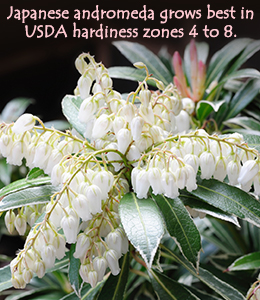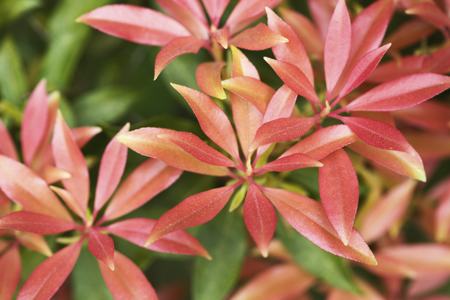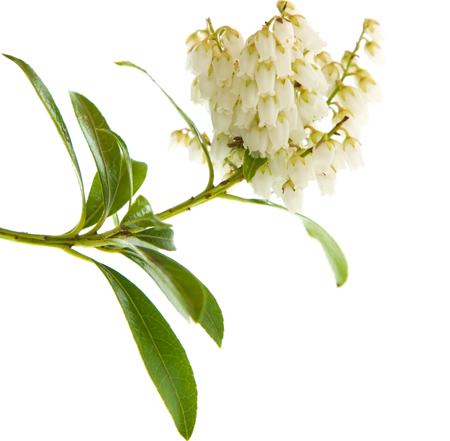Andromeda is the common name for Pieris, which is a genus that comprises seven species of evergreen shrubs. Buzzle provides information on andromeda plant care, along with tips to keep this plant healthy.

Several cultivars of the Japanese andromeda shrub have received the Royal Horticultural Society's Award of Garden Merit. These include Sarabande, Cavatine, and Purity.Among the seven species from the Pieris genus, Pieris japonica is quite popular due to its glossy foliage and drooping clusters of white or pink blooms. Also known as Japanese andromeda or the Lily of the Valley plant, this slow-growing shrub is native to Japan, Taiwan, and eastern China. Often cultivated as an ornamental plant, this broadleaf evergreen shrub belongs to the Ericaceae family. This plant is visually appealing throughout the year. During the early spring, its bright-red or bronze-colored new growth offers visual interest. Thereafter, pendulous clusters of slightly fragrant, dainty, bell-shaped flowers show up. To add to that, buds remain on this evergreen shrub throughout the winter. It's no surprise that many gardening enthusiasts are considering the inclusion of this plant to their flower garden.Andromeda Plant Profile

New Growth on Japanese Andromeda

Japanese Andromeda ShrubThe Japanese Andromeda can grow up to a height and spread of 13 feet and 8 feet, respectively. Being a slow-growing plant, it can take 10-20 years to attain this height. You can also choose to keep a dwarf Andromeda that will grow up to 3 feet. It must be noted that Andromeda japonica is poisonous. So, take the necessary precautions.Here's some information about this plant.
✦
Plant type: Evergreen shrub
✦
Genus: Pieris
✦
Family: Ericaceae
✦
Order: Ericales
✦
Scientific Name: Pieris japonica
✦
Native to: Japan Taiwan, Eastern China
✦
USDA Hardiness Zone: 4 to 8
✦
Light Requirement: Part sun, part shade
✦
Watering: Average watering
✦
Soil pH: 5 to 6, slightly acidic soil
✦
Flowers: Bell-shaped flowers
✦
Flowering Season: Late winter, early spring
✦
Colors: White
✦
Foliage Color: Broad leaves, bright red or bronze-colored new growth
✦
Propagation: From softwood cuttings in early summer and semi-hardwood cuttings in late summer
✦
Diseases: Root rot, Leaf spot
✦
Pests: Lacebug, spider mites, black vine weevils
✦
Other Characteristics: Poisonous, Resistant to deer

Drooping Flowers of Japanese Andromeda ShrubBesides Pieris japonica, other andromeda plant types or species include:
✦ Pieris floribunda (Mountain pieris)
✦ Pieris formosa (Himalayan pieris)
While Pieris floribunda is native to North America, Pieris formosa is native to eastern Himalaya, North Myanmar, and Yunnan.Andromeda Japonica Plant CareAndromeda shrubs are easy to care for. However, in order to ensure that this plant remains healthy, one needs to fulfill its soil, light, watering, and fertilizer requirements. If you are planning to bring home a Japanese andromeda shrub, here are some pointers or tips to take care of this plant.
Light Requirements
This plant will grow well if it is exposed to direct sunlight in the early morning hours. So, look for a full sun to part shade location. You need to make sure that the plant is protected from the scorching heat of the afternoon sun. Place the pot at a location where it receives partial shade for the rest of the day. In coastal areas that are cool and humid, the plant will be able to tolerate full sun. It must be noted that Andromeda bushes that are grown in full shade are less likely to produce flowers. Moreover, the color of the foliage will not be vibrant. So, choose a location where the plant is sheltered from wind, as well as harsh sun.
Soil Type
This plant will do well in well-drained soil. You can opt for a peat-based potting soil. Make sure that the container has drainage holes. Andromeda plants thrive in soil that ranges from slightly acidic to acidic. The pH of the soil should lie in the range of 5 to 6. It is advisable to enrich the soil with organic matter. Growing it in neutral or alkaline soils can make it susceptible to plant diseases (root-related) and nutrient deficiencies. Yellow leaves on andromeda shrubs, as well as poor growth is most likely to occur, if neutral and alkaline soil is used. Therefore, it is advisable to perform a soil test to determine the pH of the soil.
Watering
Make sure that you water the plant thoroughly after planting. Water it properly during the first season of growth, so that the soil remains moist. This will enable the development of the root system. Once this drought-tolerant plant is established, you can reduce the frequency of watering. Excessive watering can make the plant susceptible to root rot, so water it when the soil is dry. Mulching the base of plants with pine needles or wood chips will help keep the soil moist.
Pruning
It is advisable to prune the shrub after the flowering season, before the fruits or berries develop. So, cut off the diseased foliage or spent flowers right away. Since Andromeda buds have already formed during winter, and this shrub blooms on the previous season's growth, pruning should never be done during winter. The number of flowers might get reduced, if the shrub is pruned during winter.
Fertilizer
A light application of a general purpose water-soluble fertilizer (10-10-10), organic fertilizer, or an acid-based fertilizer will suffice. Fertilize the shrub after the flowering season. You can use the fertilizers that are meant for rhododendrons. Follow the instructions provided on the label. Refrain from sprinkling the fertilizer on the stem, trunk, or the leaves of the shrub.
Diseases
Lace bug, nematodes, and spider mites are pests that are known to cause damage to this shrub. Lace bugs and mites often have an adverse effect on the foliage. Yellowing of the leaves might be a sign of an infestation. Common diseases that affect Andromeda shrubs include phytophthora root rot and leaf spot. Phytophthora root rot is one of the diseases that can cause the leaves to wilt.Several cultivars of the Japanese andromeda shrub have gained popularity due to their glossy, vibrant-colored new growth and flowers. This plant will surely be a welcome addition to any garden. All you need to do is provide the conditions in which it will thrive.






 Several cultivars of the Japanese andromeda shrub have received the Royal Horticultural Society's Award of Garden Merit. These include Sarabande, Cavatine, and Purity.Among the seven species from the Pieris genus, Pieris japonica is quite popular due to its glossy foliage and drooping clusters of white or pink blooms. Also known as Japanese andromeda or the Lily of the Valley plant, this slow-growing shrub is native to Japan, Taiwan, and eastern China. Often cultivated as an ornamental plant, this broadleaf evergreen shrub belongs to the Ericaceae family. This plant is visually appealing throughout the year. During the early spring, its bright-red or bronze-colored new growth offers visual interest. Thereafter, pendulous clusters of slightly fragrant, dainty, bell-shaped flowers show up. To add to that, buds remain on this evergreen shrub throughout the winter. It's no surprise that many gardening enthusiasts are considering the inclusion of this plant to their flower garden.Andromeda Plant Profile
Several cultivars of the Japanese andromeda shrub have received the Royal Horticultural Society's Award of Garden Merit. These include Sarabande, Cavatine, and Purity.Among the seven species from the Pieris genus, Pieris japonica is quite popular due to its glossy foliage and drooping clusters of white or pink blooms. Also known as Japanese andromeda or the Lily of the Valley plant, this slow-growing shrub is native to Japan, Taiwan, and eastern China. Often cultivated as an ornamental plant, this broadleaf evergreen shrub belongs to the Ericaceae family. This plant is visually appealing throughout the year. During the early spring, its bright-red or bronze-colored new growth offers visual interest. Thereafter, pendulous clusters of slightly fragrant, dainty, bell-shaped flowers show up. To add to that, buds remain on this evergreen shrub throughout the winter. It's no surprise that many gardening enthusiasts are considering the inclusion of this plant to their flower garden.Andromeda Plant Profile New Growth on Japanese Andromeda
New Growth on Japanese Andromeda Japanese Andromeda ShrubThe Japanese Andromeda can grow up to a height and spread of 13 feet and 8 feet, respectively. Being a slow-growing plant, it can take 10-20 years to attain this height. You can also choose to keep a dwarf Andromeda that will grow up to 3 feet. It must be noted that Andromeda japonica is poisonous. So, take the necessary precautions.Here's some information about this plant.
Japanese Andromeda ShrubThe Japanese Andromeda can grow up to a height and spread of 13 feet and 8 feet, respectively. Being a slow-growing plant, it can take 10-20 years to attain this height. You can also choose to keep a dwarf Andromeda that will grow up to 3 feet. It must be noted that Andromeda japonica is poisonous. So, take the necessary precautions.Here's some information about this plant. Drooping Flowers of Japanese Andromeda ShrubBesides Pieris japonica, other andromeda plant types or species include:
Drooping Flowers of Japanese Andromeda ShrubBesides Pieris japonica, other andromeda plant types or species include: